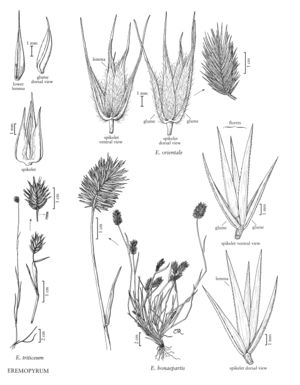Difference between revisions of "Eremopyrum triticeum"
FNA>Volume Importer |
imported>Volume Importer |
||
| (4 intermediate revisions by 2 users not shown) | |||
| Line 4: | Line 4: | ||
|publications= | |publications= | ||
|common_names=Annual wheatgrass | |common_names=Annual wheatgrass | ||
| + | |special_status={{Treatment/ID/Special_status | ||
| + | |code=I | ||
| + | |label=Introduced | ||
| + | }} | ||
|basionyms= | |basionyms= | ||
|synonyms={{Treatment/ID/Synonym | |synonyms={{Treatment/ID/Synonym | ||
|name=Agropyron triticeum | |name=Agropyron triticeum | ||
| − | |authority= | + | |authority= |
| + | |rank=species | ||
}} {{Treatment/ID/Synonym | }} {{Treatment/ID/Synonym | ||
|name=Agropyron prostratum | |name=Agropyron prostratum | ||
| − | |authority= | + | |authority= |
| + | |rank=species | ||
}} | }} | ||
|hierarchy=Poaceae;Poaceae subfam. Pooideae;Poaceae tribe Triticeae;Eremopyrum;Eremopyrum triticeum | |hierarchy=Poaceae;Poaceae subfam. Pooideae;Poaceae tribe Triticeae;Eremopyrum;Eremopyrum triticeum | ||
| Line 23: | Line 29: | ||
-->{{Treatment/Body | -->{{Treatment/Body | ||
|distribution=Colo.;N.Mex.;Wash.;N.Y.;Utah;Wyo.;Nebr.;Oreg.;Mont.;Alta.;B.C.;Man.;Sask.;Idaho;Ariz.;Nev. | |distribution=Colo.;N.Mex.;Wash.;N.Y.;Utah;Wyo.;Nebr.;Oreg.;Mont.;Alta.;B.C.;Man.;Sask.;Idaho;Ariz.;Nev. | ||
| − | |discussion=<p>Eremopyrum triticeum is known primarily from scattered disturbed sites in western North America, from southern Canada to Arizona and New Mexico. Like most weeds, it is probably more widely distributed than herbarium records indicate. It is tolerant of alkaline soils, and is summer-dormant.</p> | + | |discussion=<p><i>Eremopyrum triticeum</i> is known primarily from scattered disturbed sites in western North America, from southern Canada to Arizona and New Mexico. Like most weeds, it is probably more widely distributed than herbarium records indicate. It is tolerant of alkaline soils, and is summer-dormant.</p> |
|tables= | |tables= | ||
|references= | |references= | ||
| Line 32: | Line 38: | ||
-->{{#Taxon: | -->{{#Taxon: | ||
name=Eremopyrum triticeum | name=Eremopyrum triticeum | ||
| − | |||
|authority=(Gaertn.) Nevski | |authority=(Gaertn.) Nevski | ||
|rank=species | |rank=species | ||
| Line 40: | Line 45: | ||
|family=Poaceae | |family=Poaceae | ||
|illustrator=Cindy Roché | |illustrator=Cindy Roché | ||
| + | |illustration copyright=Utah State University | ||
|distribution=Colo.;N.Mex.;Wash.;N.Y.;Utah;Wyo.;Nebr.;Oreg.;Mont.;Alta.;B.C.;Man.;Sask.;Idaho;Ariz.;Nev. | |distribution=Colo.;N.Mex.;Wash.;N.Y.;Utah;Wyo.;Nebr.;Oreg.;Mont.;Alta.;B.C.;Man.;Sask.;Idaho;Ariz.;Nev. | ||
|reference=None | |reference=None | ||
|publication title= | |publication title= | ||
|publication year= | |publication year= | ||
| − | |special status= | + | |special status=Introduced |
| − | |source xml=https:// | + | |source xml=https://bitbucket.org/aafc-mbb/fna-data-curation/src/200273ad09963decb8fc72550212de541d86569d/coarse_grained_fna_xml/V24/V24_363.xml |
|subfamily=Poaceae subfam. Pooideae | |subfamily=Poaceae subfam. Pooideae | ||
|tribe=Poaceae tribe Triticeae | |tribe=Poaceae tribe Triticeae | ||
Latest revision as of 16:23, 11 May 2021
Culms to 30 cm, mostly glab¬rous, puberulent below the spikes. Sheaths of upper leaves inflated; blades 1-3(6) mm wide, scabrous or shortly pilose distally. Spikes 1.3-2.4 cm long, 0.8-2 cm wide, elliptic, ovate, or nearly circular in outline; disarticulation beneath each floret, sometimes at the base of the spikes, not in the rachises. Spikelets 6-12 mm, with 2-3 florets. Glumes 4-7.5 mm, glabrous, 1-veined and -keeled, becoming 2-keeled by the development of a ridge adjacent to the vein, bases prominently inflated and curved; lemmas 5-7.5 mm, prominently keeled towards the subulate apices, lowest lemma in each spikelet pubescent on the proximal 1/2, hairs 0.1-0.15 mm, glabrous distally, the other lemmas glabrous; palea keels not prolonged. 2n = 14.
Distribution
Colo., N.Mex., Wash., N.Y., Utah, Wyo., Nebr., Oreg., Mont., Alta., B.C., Man., Sask., Idaho, Ariz., Nev.
Discussion
Eremopyrum triticeum is known primarily from scattered disturbed sites in western North America, from southern Canada to Arizona and New Mexico. Like most weeds, it is probably more widely distributed than herbarium records indicate. It is tolerant of alkaline soils, and is summer-dormant.
Selected References
None.
